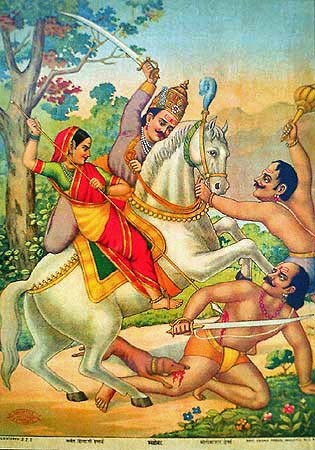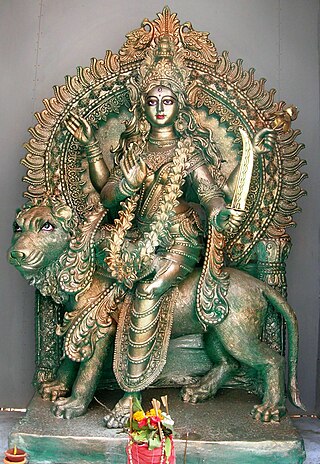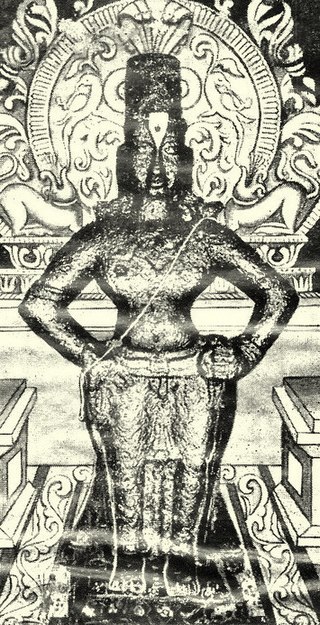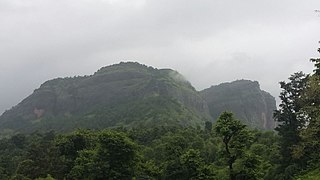Related Research Articles

Bhavānī is an epithet associated with Adi Shakti (Durga). Bhavani translates to "giver of life," meaning the power of nature or the source of creative energy. She is considered to be a nurturing mother figure who provides for her devotees and also plays the role of dispensing justice by killing evil Asuras.
The Maratha caste is composed of 96 clans, originally formed in the earlier centuries from the amalgamation of families from the peasant (Kunbi), shepherd (Dhangar), blacksmith (Lohar), pastoral (Gavli), carpenter (Sutar), Bhandari, Thakar and Koli castes in Maharashtra. Many of them took to military service in the 16th century for the Deccan sultanates or the Mughals. Later in the 17th and 18th centuries, they served in the armies of the Maratha Kingdom, founded by Shivaji, a Maratha Kunbi by caste. Many Marathas were granted hereditary fiefs by the Sultanates, and Mughals for their service.

Kunbi is a generic term applied to several castes of traditional farmers in Western India. These include the Dhonoje, Ghatole, Masaram, Hindre, Jadav, Jhare, Khaire, Lewa, Lonare and Tirole communities of Vidarbha. The communities are largely found in the state of Maharashtra but also exist in the states of Madhya Pradesh, Gujarat, Karnataka, Kerala and Goa. Kunbis are included among the Other Backward Classes (OBC) in Maharashtra.
Deshastha Brahmin is a Hindu Brahmin subcaste mainly from the Indian state of Maharashtra and North Karnataka. Other than these states, according to authors K. S. Singh, Gregory Naik and Pran Nath Chopra, Deshastha Brahmins are also concentrated in the states of Telangana (which was earlier part of Hyderabad State and Berar Division), Andhra Pradesh and Madhya Pradesh (Which was earlier part of Central Provinces and Berar) Historian Pran Nath Chopra and journalist Pritish Nandy say, "Most of the well-known saints from Maharashtra, Karnataka and Andhra Pradesh were Deshastha Brahmins". The mother tongue of Deshastha Brahmins is either Marathi, Kannada or Telugu.
The Dhangars are caste of people found in the Indian states of Maharashtra, northern Karnataka, Goa, Madhya Pradesh. They are referred to as Gavli Dhangars in northern Maharashtra and the forested hill tracts of India's Western Ghats, there are many distinct Gavli castes in Maharashtra and Dhangar Gavli is one of them.
Navadurga, also spelled Navdurga and Navadurgas, are nine manifestations and forms of Durga in Hinduism, especially worshipped during Navaratri and Durga Puja. They are often considered collectively as a single deity, mainly among the followers of Shaktism and Shaivism sect of Hinduism.

Khandoba, also known as Martanda Bhairava,, Malhari,Mylaralinga,Bandarada Odeya and Malhar, is a Hindu deity worshiped as a manifestation of Shiva mainly in the Deccan plateau of India, especially in the state of Maharashtra and North Karnataka. He is the most popular Kuladevata in Maharashtra. He is also the patron deity of some warrior, farming castes, shepherd community and Brahmin (priestly) castes as well as several of the hunter/gatherer tribes that are native to the hills and forests of this region. The sect of Khandoba has linkages with Hindu and Jain traditions, and also assimilates all communities irrespective of caste, including Muslims. The form of Khandoba developed during the 9th and 10th centuries from a folk deity into a composite god possessing the attributes of Shiva, Bhairava, Surya and Kartikeya (Skanda). He is depicted either in the form of a linga, or as an image of a warrior riding on a bull or a horse. The foremost centre of Khandoba worship is the Khandoba temple of Jejuri in Maharashtra. The legends of Khandoba, found in the text Malhari Mahatmya and also narrated in folk songs, revolve around his victory over demons Mani-malla and his marriages.

Katyayani (कात्यायनी) is an aspect of Mahadevi and the slayer of the tyrannical demon Mahishasura. She is the sixth among the Navadurgas, the nine forms of Hindu goddess Durga who are worshipped during the festival of Navaratri. She is depicted with four, ten or eighteen hands. This is the second name given to the goddess Adi Parashakti in Amarakosha, the Sanskrit lexicon.

Vithoba, also known as Vitthala, and Panduranga, is a Hindu deity predominantly worshipped in the Indian state of Maharashtra and Karnataka. He is a form of the Hindu deity Vishnu in his avatar: Krishna. Vithoba is often depicted as a dark young boy, standing arms akimbo on a brick, sometimes accompanied by his consort Rakhumai.

The Marathi people or Marathis are an Indo-Aryan ethnolinguistic group who are native to Maharashtra in western India. They natively speak Marathi, an Indo-Aryan language. Maharashtra was formed as a Marathi-speaking state of India on 1 May 1960, as part of a nationwide linguistic reorganisation of the Indian states. The term "Maratha" is generally used by historians to refer to all Marathi-speaking peoples, irrespective of their caste; However, it may refer to a Maharashtrian caste known as the Maratha which also includes farmer sub castes like the Kunbis.

Sudhagad / Bhorapgad is a hill fort situated in Maharashtra, India. It lies about 53 kilometres (33 mi) west of Pune, 26 kilometres (16 mi) south of Lonavla and 11 kilometres (6.8 mi) east of Pali in Raigad District. The summit is 620 metres (2,030 ft) above sea level. The entire area around the fort is declared a Sudhagad wildlife sanctuary.

Saptashrungi or Saptashringi is a site of Hindu pilgrimage situated 60 kilometres (37 mi) from Nashik in Indian state of Maharashtra. According to Hindu traditions, the goddess Saptashrungi Nivasini dwells within the seven mountain peaks. It is located in Nanduri, Kalwan taluka, a small village near Nashik in India. The Marathas and some Hindu tribes have worshipped the goddess from a long time and some worship her as their kuldaivat. There are 510 steps to climb the gad. To go from below to the temple, the temple trust has also provided the facility of a furnacular trolley. Its work started in July 2018. There are a total of 6 coaches in this trolley, and 10 passengers can sit in one coach. This trolley takes 3 minutes to reach the temple. Passengers have to climb 20 to 25 stairs to go from the station above the trolley to the temple. This trolley carries about 5000 passengers every day. Devotees visit this place in large numbers every day. The temple is also known popularly as one of the "three and half Shakti Peethas" of Maharashtra. The temple is also one among the 51 Shakti Peethas located on the Indian subcontinent and is a location where one of Sati's limbs, her right arm is reported to have fallen. Its half shaktipeeth among three and half shaktipeeth of Maharashtra.

A kuladevata or kuladevi, also known as a kuladaivaṃ, is an ancestral tutelary deity in Hinduism and Jainism.

The Mali are an occupational caste found among the Hindus who traditionally worked as gardeners and florists. They also call themselves Phul Mali due to their occupation of growing flowers. The Mali are found throughout North India, East India as well as the Terai region of Nepal and Maharashtra. Iravati Karve, an anthropologist, showed how the Maratha caste was generated from Kunbis who simply started calling themselves "Maratha". She states that Maratha, Kunbi and Mali are the three main farming communities of Maharashtra – the difference being that the Marathas and Kunbis were "dry farmers" whereas the Mali farmed throughout the year.
The Jadhav is an clan (Gotra) found in the several castes such as Koli, Maratha, Banjara and Mangs living in Indian states of Maharashtra, Goa, Karnataka, Telangana
The Mane are a Maratha clan found largely in Maharashtra, Karnataka and neighbouring states of India. The name Mane is derived from the Marathi word man ("neck")

The practice of Hindu animal sacrifice is in recent times mostly associated with Shaktism, and in currents of folk Hinduism strongly rooted in local popular or tribal traditions. Animal sacrifices were part of the ancient Vedic Era in India, and are mentioned in scriptures such as the Puranas. The Hindu scripture Brahma Vaivarta Purana forbids the Asvamedha Horse sacrifice in this Kali Yuga. However, the perception that animal sacrifice was only practiced in ancient Non-Vedic Era is opposed by instances like Ashvamedha and other rituals that are rooted in Vedas. Both the Itihasas and the Puranas like the Devi Bhagavata Purana and the Kalika Purana as well as the Saiva and Sakta Agamas prescribe animal sacrifices.
Marathi Brahmins are communities native to the Indian state of Maharashtra. They are classified into mainly three sub-divisions based on their places of origin, "Desh", "Karad" and "Konkan". The Brahmin subcastes that come under Maharashtra Brahmins include Deshastha, Chitpavan (Konkanastha), Saraswat, Karhade, and Devrukhe.
The Kaikadi are a community in the Indian states of Maharashtra and Karnataka. Their name is derived from kai and kade, while the community derives its name from kai and kadi. Traditionally, they were nomadic, mainly wandering in the Vidarbha region of the state, but most have now settled down. They speak Kaikadi, a Dravidian language closely related to Tamil with significant Indo-Aryan admixture. They practice the puberty function like other Tamil communities.
The Son Koli, or Sona Koli is a subcaste of the Koli caste found in the Indian state of Maharashtra. The Son Kolis are the original residents of what is now Mumbai, the capital of Maharashtra. They practice both Hinduism and Christianity because Son Kolis were converted to Christianity during the Portuguese rule in India and worship Our Lady of Mount and Hindu deities. Historically, the Son Kolis have been fisherman by profession.
References
- 1 2 Drury, Nevill (2004). The dictionary of the esoteric: 3000 entries on the mystical and occult traditions. Motilal Banarsidass. p. 285. ISBN 978-81-208-1989-4.
- ↑ Fuller, Christopher John (2004). The camphor flame: popular Hinduism and society in India. Princeton University Press. p. 144. ISBN 978-0-691-12048-5.
- ↑ Berkson, Carmel (1995). The divine and demoniac: Mahisa's heroic struggle with Durga. Oxford University Press. p. 85. ISBN 978-0-19-563555-3.
- ↑ Rosalind 'O' Hanlon (2002). Caste, Conflict and Ideology: Mahatma Jotirao Phule and Low Caste Protest in Nineteenth-Century Western India (Cambridge South Asian Studies). Cambridge University Press. p. 155. ISBN 9780521523080.
- ↑ "Professor Rosalind O'Hanlon | St Cross College". Archived from the original on 2013-06-19.
- ↑ Sacred Animals of India. Penguin. 2014. ISBN 9788184751826.
- ↑ J. N. Kamalapur (1961). The Deccan Forts: A Study in the Art of Fortification in Mediaeval India. Popular Book Depot. p. 37.
A little further is a beautiful reservoir called Mhasoba Taki, a source of constant supply of water
- ↑ Milind Gunaji (2010). Offbeat Tracks in Maharashtra. popular prakashan. p. 65. ISBN 9788179915783.
- ↑ "Devdutt Pattanaik: The forgotten Buffalo King". 9 June 2018.
- ↑ "The riddle of Mhatoba, Mhaskoba and Mahishasura". 28 March 2016.
- ↑ "Mhasoba Mandir". map.sahapedia.org. Retrieved 2023-08-30.
- ↑ "The riddle of Mhatoba, Mhaskoba and Mahishasura". The Indian Express. 2016-03-28. Retrieved 2023-08-30.
- ↑ Bhanu, B. V. (2004). Maharashtra. Popular Prakashan. ISBN 9788179911006.
- ↑ Berkson; pg. xiii
- ↑ Kosambi, Damodar Dharmanand (1962). Myth and reality: studies in the formation of Indian culture. Popular Prakashan. pp. 90. ISBN 978-81-7154-870-5.
Maharastra durga.
- 1 2 3 Singh, Kumar Suresh; Bhanu, B. V.; India, Anthropological Survey of (2004). Maharashtra. Popular Prakashan. ISBN 978-81-7991-101-3.
- 1 2 Rāmarāju, Bi (1991). Glimpses Into Telugu Folklore. Janapada Vijnana Prachuranalu.
- 1 2 3 4 Danda, Ajit K. (1993). Weaker Sections in Indian Villages. Inter-India Publications. ISBN 978-81-210-0305-6.
- ↑ Festival:Previously the event was celebrated as \'Masoba yatra\' in Sulud
